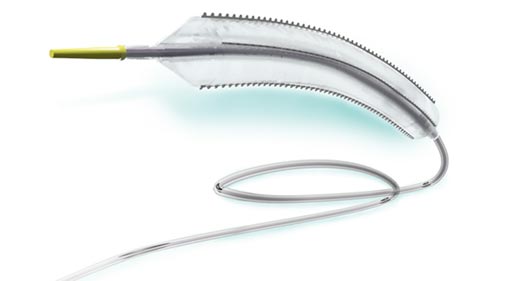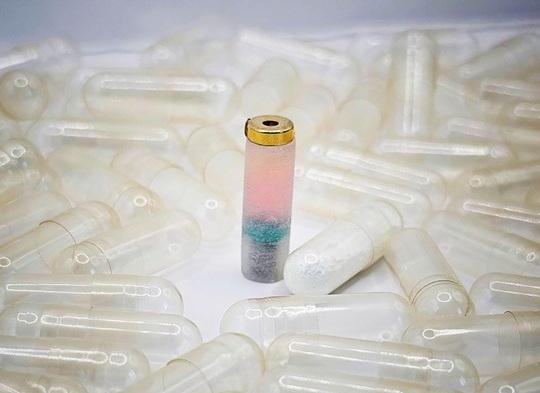Vessel Dilation Device Advances Peripheral Artery Interventions
|
By HospiMedica International staff writers Posted on 17 Mar 2017 |

Image: The Serranator Alto percutaneous transluminal angioplasty balloon (Photo courtesy of Cagent Vascular).
A novel dilation balloon creates multiple longitudinal micro-serrations in order to help the expansion of blood vessels in peripheral artery disease (PAD).
The Cagent Vascular Serranator Alto combines mechanical percutaneous transluminal angioplasty (PTA) balloon dilatation and multiple serrated scoring elements in order to create linear, interrupted scoring along the endoluminal surface of peripheral arteries. The teeth-like ridges are located on four sides of the dilation balloon; as it is pumped with saline to expand a constricted vessel, the ridges create tiny serrations lines help guide the expansion of the arteries.
The Serranator Alto is intended for dilatation of PAD lesions in the iliac, femoral, iliofemoral, and popliteal arteries, as well as for the treatment of obstructive lesions of native or synthetic arteriovenous (AV) dialysis fistulae. The need for the device, according to the company, arises from an increasingly aging population, increased incidence of obesity, type-2 diabetes, smoking, and hypercholesterolemia, all of which contribute to an increased lesion complexity in PDA.
“A new approach to vessel dilatation is long overdue for treatment of diseased peripheral arteries; today we are treating more complex lesions that require better tools,” said vascular surgeon Peter Schneider, MD, co-founder and chief medical officer of Cagent Vascular. “We believe serration technology will prove to be effective in more complex lesions and will evolve into the new standard of care for vessel dilatation. In the future we hope to show clinical benefit as a vessel preparation tool with new technologies, such as drug coated balloons.”
“We have also begun the development of the Serranator Bass for treatment of the below-the-knee or infrapopliteal arteries, where new technologies are desperately needed for the treatment of critical limb ischemia,” said Carol Burns, CEO of Cagent Vascular. “Future applications of interest include serration technology for vessel preparation prior to the use of bioresorbable scaffolds in coronary arteries.”
PAD results when the peripheral arteries become too narrow or obstructed due to plaque, limiting blood flow to the legs. If left untreated, it can cause pain or aching in the legs, difficulty with walking, resting pain in the foot at night while lying down, and non-healing sores or infections in the toes or feet; PAD can ultimately lead to limb loss in its most severe form. In addition, it can be associated with other serious arterial conditions that can lead to heart attacks and stroke.
The Cagent Vascular Serranator Alto combines mechanical percutaneous transluminal angioplasty (PTA) balloon dilatation and multiple serrated scoring elements in order to create linear, interrupted scoring along the endoluminal surface of peripheral arteries. The teeth-like ridges are located on four sides of the dilation balloon; as it is pumped with saline to expand a constricted vessel, the ridges create tiny serrations lines help guide the expansion of the arteries.
The Serranator Alto is intended for dilatation of PAD lesions in the iliac, femoral, iliofemoral, and popliteal arteries, as well as for the treatment of obstructive lesions of native or synthetic arteriovenous (AV) dialysis fistulae. The need for the device, according to the company, arises from an increasingly aging population, increased incidence of obesity, type-2 diabetes, smoking, and hypercholesterolemia, all of which contribute to an increased lesion complexity in PDA.
“A new approach to vessel dilatation is long overdue for treatment of diseased peripheral arteries; today we are treating more complex lesions that require better tools,” said vascular surgeon Peter Schneider, MD, co-founder and chief medical officer of Cagent Vascular. “We believe serration technology will prove to be effective in more complex lesions and will evolve into the new standard of care for vessel dilatation. In the future we hope to show clinical benefit as a vessel preparation tool with new technologies, such as drug coated balloons.”
“We have also begun the development of the Serranator Bass for treatment of the below-the-knee or infrapopliteal arteries, where new technologies are desperately needed for the treatment of critical limb ischemia,” said Carol Burns, CEO of Cagent Vascular. “Future applications of interest include serration technology for vessel preparation prior to the use of bioresorbable scaffolds in coronary arteries.”
PAD results when the peripheral arteries become too narrow or obstructed due to plaque, limiting blood flow to the legs. If left untreated, it can cause pain or aching in the legs, difficulty with walking, resting pain in the foot at night while lying down, and non-healing sores or infections in the toes or feet; PAD can ultimately lead to limb loss in its most severe form. In addition, it can be associated with other serious arterial conditions that can lead to heart attacks and stroke.
Latest Surgical Techniques News
- Minimally Invasive Endoscopic Surgery Improves Severe Stroke Outcomes
- Novel Glue Prevents Complications After Breast Cancer Surgery
- Breakthrough Brain Implant Enables Safer and More Precise Drug Delivery
- Bioadhesive Sponge Stops Uncontrolled Internal Bleeding During Surgery
- Revolutionary Nano Bone Material to Accelerate Surgery and Healing
- Superior Orthopedic Implants Combat Infections and Quicken Healing After Surgery
- Laser-Based Technique Eliminates Pancreatic Tumors While Protecting Healthy Tissue
- Surgical Treatment of Severe Carotid Artery Stenosis Benefits Blood-Brain Barrier
- Revolutionary Reusable Duodenoscope Introduces 68-Minute Sterilization
- World's First Transcatheter Smart Implant Monitors and Treats Congestion in Heart Failure
- Hybrid Endoscope Marks Breakthrough in Surgical Visualization
- Robot-Assisted Bronchoscope Diagnoses Tiniest and Hardest to Reach Lung Tumors
- Diamond-Titanium Device Paves Way for Smart Implants that Warn of Disease Progression
- 3D Printable Bio-Active Glass Could Serve as Bone Replacement Material
- Spider-Inspired Magnetic Soft Robots to Perform Minimally Invasive GI Tract Procedures
- Micro Imaging Device Paired with Endoscope Spots Cancers at Earlier Stage
Channels
Critical Care
view channel
AI Heart Attack Risk Assessment Tool Outperforms Existing Methods
For decades, doctors have relied on standardized scoring systems to assess patients with the most common type of heart attack—non-ST-elevation acute coronary syndrome (NSTE-ACS). The GRACE score, used... Read more
'Universal' Kidney to Match Any Blood Type
Blood-type incompatibility has long been one of the greatest obstacles in organ transplantation, forcing thousands of patients—particularly those with type O blood—to wait years longer for compatible donors.... Read morePatient Care
view channel
Revolutionary Automatic IV-Line Flushing Device to Enhance Infusion Care
More than 80% of in-hospital patients receive intravenous (IV) therapy. Every dose of IV medicine delivered in a small volume (<250 mL) infusion bag should be followed by subsequent flushing to ensure... Read more
VR Training Tool Combats Contamination of Portable Medical Equipment
Healthcare-associated infections (HAIs) impact one in every 31 patients, cause nearly 100,000 deaths each year, and cost USD 28.4 billion in direct medical expenses. Notably, up to 75% of these infections... Read more
Portable Biosensor Platform to Reduce Hospital-Acquired Infections
Approximately 4 million patients in the European Union acquire healthcare-associated infections (HAIs) or nosocomial infections each year, with around 37,000 deaths directly resulting from these infections,... Read moreFirst-Of-Its-Kind Portable Germicidal Light Technology Disinfects High-Touch Clinical Surfaces in Seconds
Reducing healthcare-acquired infections (HAIs) remains a pressing issue within global healthcare systems. In the United States alone, 1.7 million patients contract HAIs annually, leading to approximately... Read moreHealth IT
view channel
Printable Molecule-Selective Nanoparticles Enable Mass Production of Wearable Biosensors
The future of medicine is likely to focus on the personalization of healthcare—understanding exactly what an individual requires and delivering the appropriate combination of nutrients, metabolites, and... Read moreBusiness
view channel
Philips and Masimo Partner to Advance Patient Monitoring Measurement Technologies
Royal Philips (Amsterdam, Netherlands) and Masimo (Irvine, California, USA) have renewed their multi-year strategic collaboration, combining Philips’ expertise in patient monitoring with Masimo’s noninvasive... Read more
B. Braun Acquires Digital Microsurgery Company True Digital Surgery
The high-end microsurgery market in neurosurgery, spine, and ENT is undergoing a significant transformation. Traditional analog microscopes are giving way to digital exoscopes, which provide improved visualization,... Read more
CMEF 2025 to Promote Holistic and High-Quality Development of Medical and Health Industry
The 92nd China International Medical Equipment Fair (CMEF 2025) Autumn Exhibition is scheduled to be held from September 26 to 29 at the China Import and Export Fair Complex (Canton Fair Complex) in Guangzhou.... Read more














